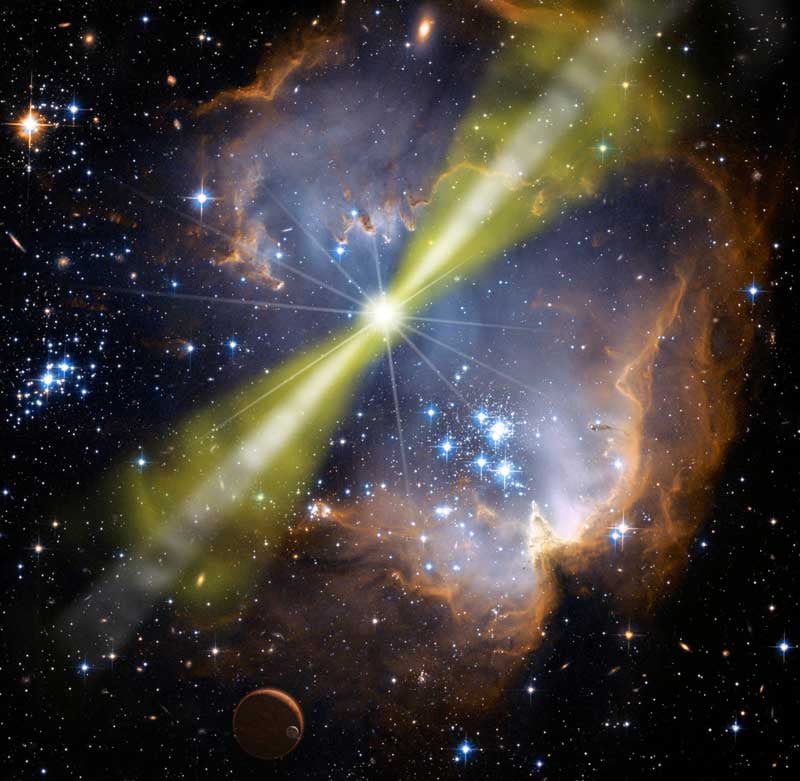Science
Powerful Gamma Ray Burst Unveils Secrets of Cosmic Jets

In October 2022, astronomers observed the most powerful gamma ray burst ever recorded, designated as GRB 221009A and referred to as the “Brightest Of All Time” (BOAT). This extraordinary event released energy in mere seconds that surpasses the total output of our Sun over its entire 10 billion year lifespan. The burst overwhelmed multiple detection instruments, but subsequent observations are now shedding light on the complex mechanisms behind these cosmic phenomena.
Gamma ray bursts are among the universe’s most intense events, occurring when massive stars collapse into black holes or when neutron stars collide. The initial explosion lasts only a few seconds to minutes, followed by an afterglow that can persist for hours or even months. Observing these bursts is notoriously difficult since they originate from galaxies billions of light years away, causing their gamma rays to weaken significantly by the time they reach Earth.
Breakthrough Observations from Multiple Telescopes
Following the eruption of GRB 221009A, global follow-up observations commenced. The Large Sized Telescope (LST-1) in La Palma, Spain, began its analysis just 1.33 days after the explosion. Over a span of 20 days, researchers uncovered unexpected data revealing an excess of high-energy gamma rays from the burst’s afterglow. Although this signal did not meet the formal detection criteria, it provided crucial insights into the structure and behavior of the burst.
These findings challenge the longstanding notions surrounding gamma ray bursts. Traditionally, it was believed that these explosions produced simple, uniform jets of plasma. However, the data from LST-1 indicates that GRB 221009A may have involved a structured jet, characterized by a fast-moving core surrounded by a slower-moving shell of material. This structured jet model offers explanations for how particles are accelerated to extreme energies and clarifies the observed radiation patterns.
The data collection by LST-1 was particularly remarkable, as it successfully gathered information under bright moonlight conditions. This presented a significant challenge due to the telescope’s sensitive cameras. While the full Moon hindered other telescopes from observing GRB 221009A, technical advancements by the LST team enabled continued observations. Their innovative techniques are likely to enhance future studies of transient astronomical events, even under traditionally unfavorable conditions.
A New Era in High-Energy Astrophysics
The success of the observations related to GRB 221009A signifies the dawn of a new era in high-energy astrophysics. Researchers are now poised to delve deeper into the inner workings of astronomical sources with unprecedented detail. The implications of these findings extend beyond understanding gamma ray bursts; they represent a pivotal moment for the study of cosmic jets and their formation.
As scientists continue to unravel the complexities of GRB 221009A, the collaboration among various observatories and instruments highlights the importance of global efforts in advancing our understanding of the universe. The insights gained from this extraordinary burst not only illuminate the mechanisms behind one of the most powerful events in the cosmos but also pave the way for future discoveries in high-energy astrophysics.
-

 Technology5 months ago
Technology5 months agoDiscover the Top 10 Calorie Counting Apps of 2025
-

 Technology3 weeks ago
Technology3 weeks agoOpenAI to Implement Age Verification for ChatGPT by December 2025
-

 Health3 months ago
Health3 months agoBella Hadid Shares Health Update After Treatment for Lyme Disease
-

 Health4 months ago
Health4 months agoAnalysts Project Stronger Growth for Apple’s iPhone 17 Lineup
-

 Health4 months ago
Health4 months agoErin Bates Shares Recovery Update Following Sepsis Complications
-

 Technology5 months ago
Technology5 months agoDiscover How to Reverse Image Search Using ChatGPT Effortlessly
-

 Technology3 months ago
Technology3 months agoElectric Moto Influencer Surronster Arrested in Tijuana
-

 Technology5 months ago
Technology5 months agoMeta Initiates $60B AI Data Center Expansion, Starting in Ohio
-

 Technology2 months ago
Technology2 months agoDiscover 2025’s Top GPUs for Exceptional 4K Gaming Performance
-

 Technology5 months ago
Technology5 months agoRecovering a Suspended TikTok Account: A Step-by-Step Guide
-

 Health5 months ago
Health5 months agoTested: Rab Firewall Mountain Jacket Survives Harsh Conditions
-

 Lifestyle5 months ago
Lifestyle5 months agoBelton Family Reunites After Daughter Survives Hill Country Floods




















